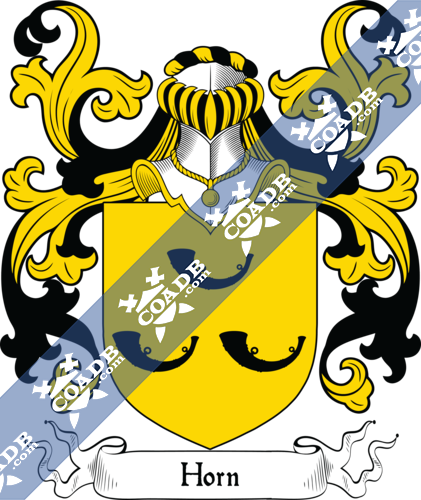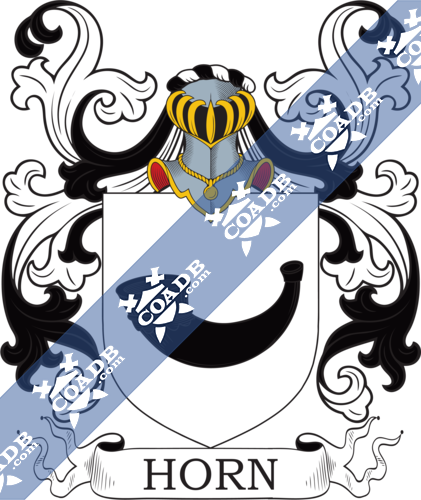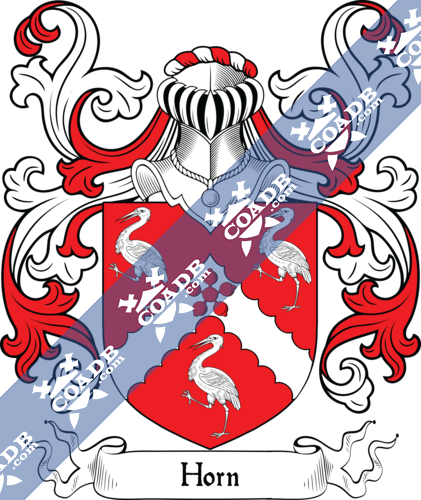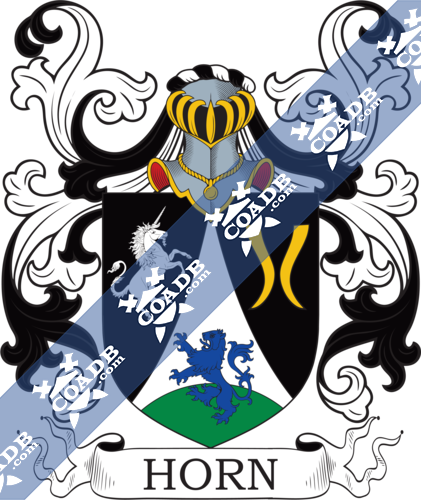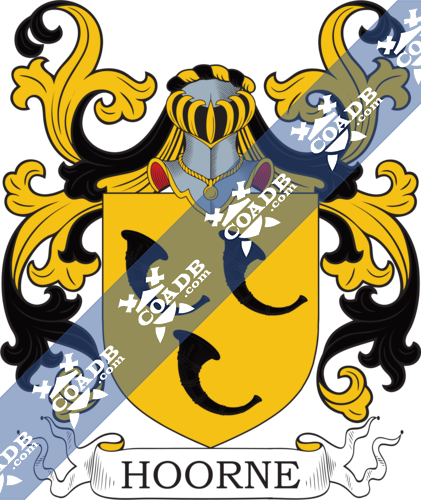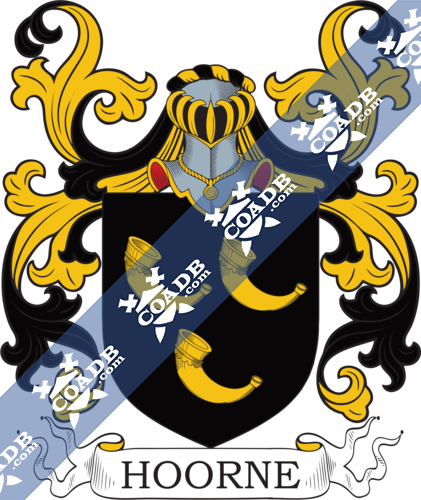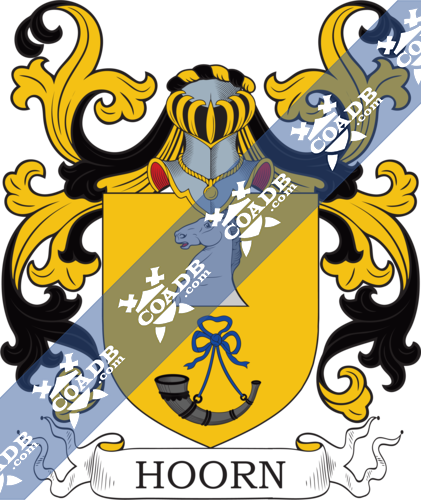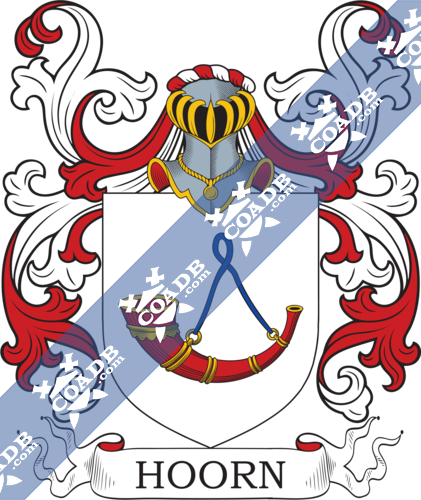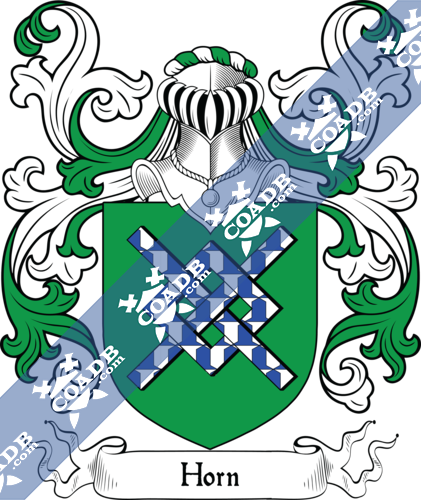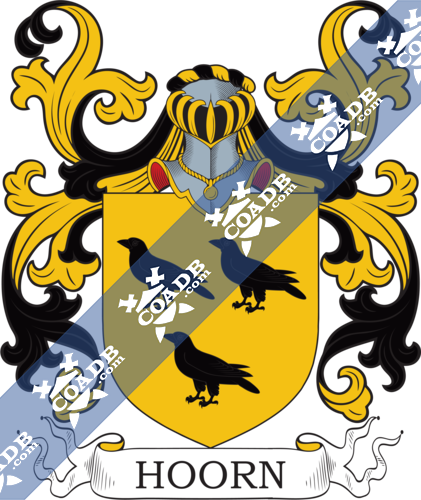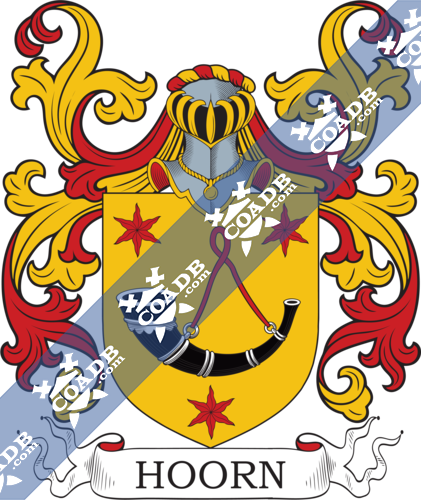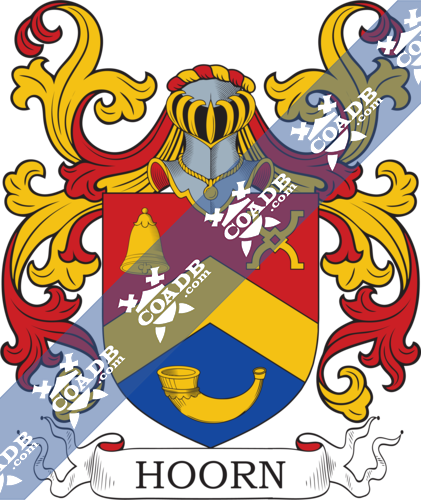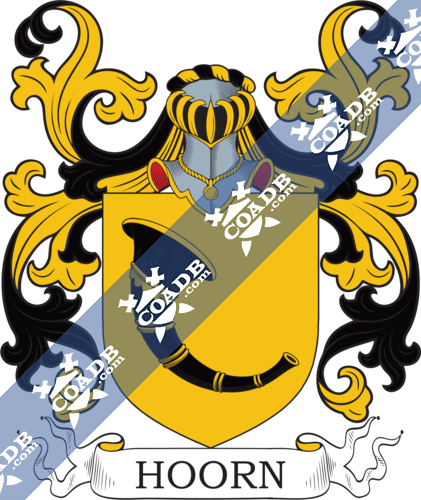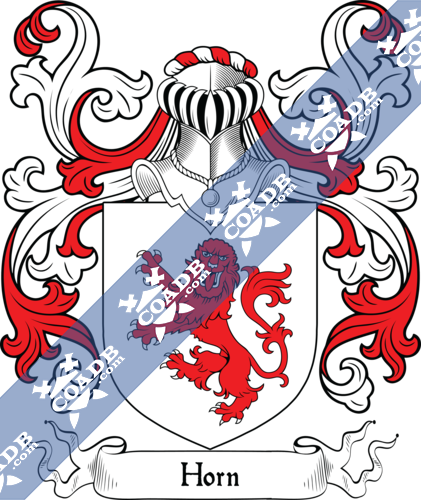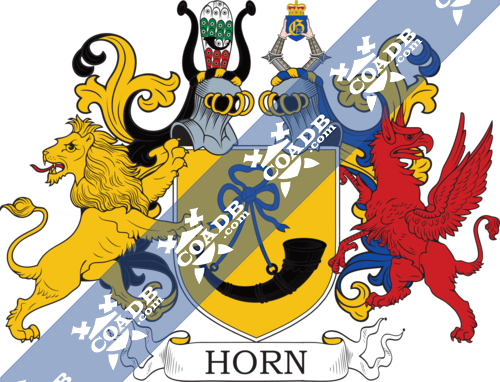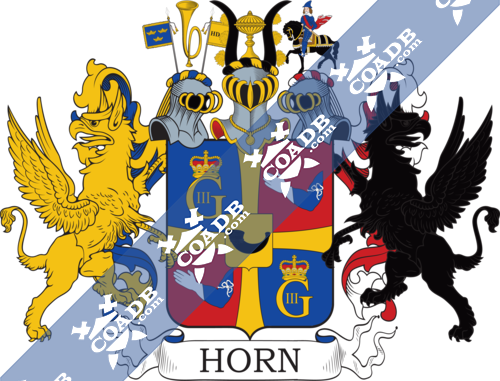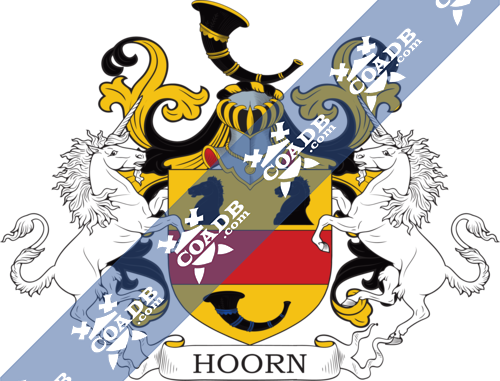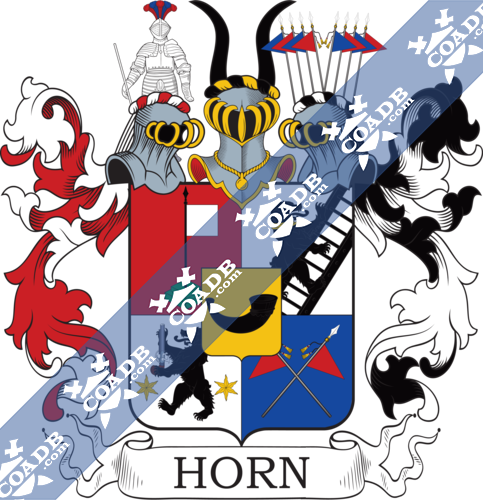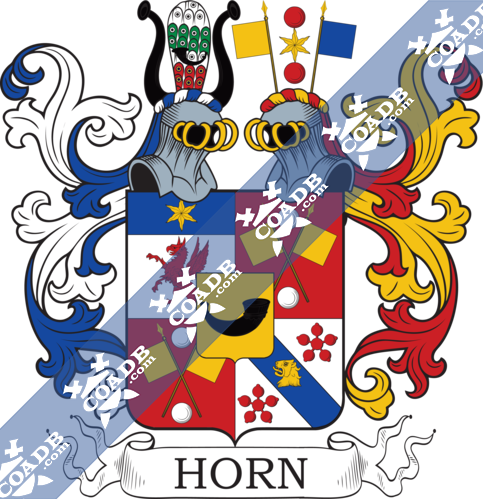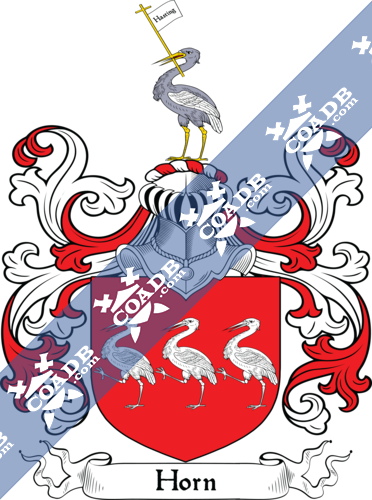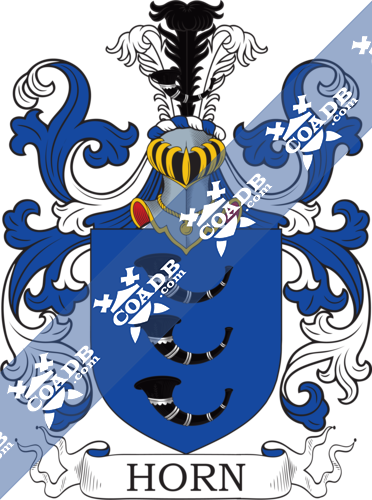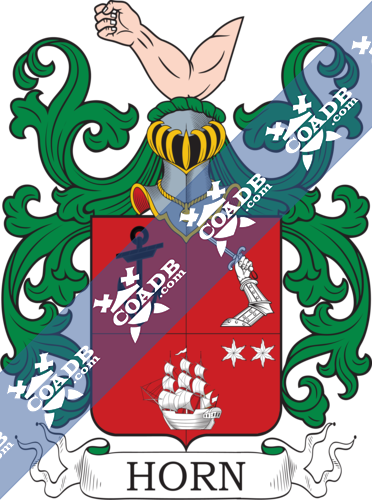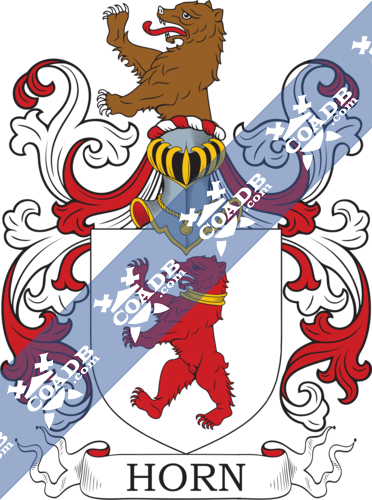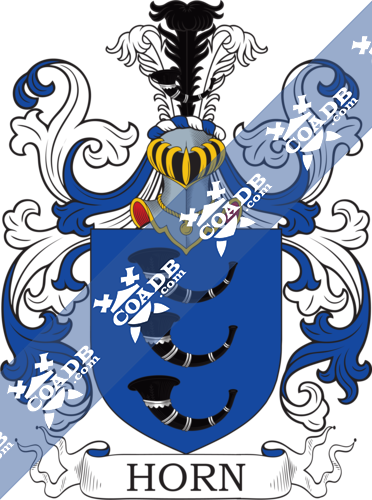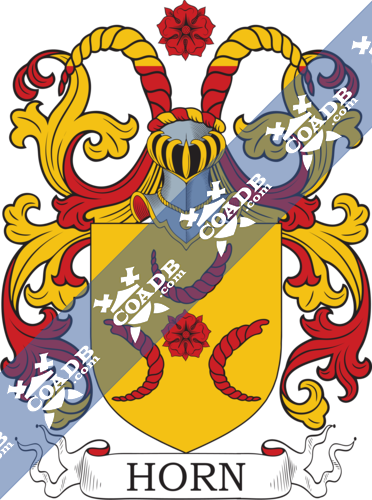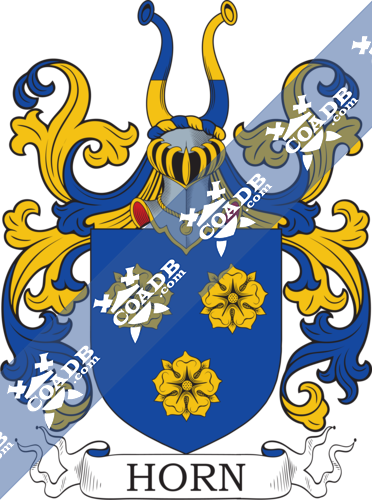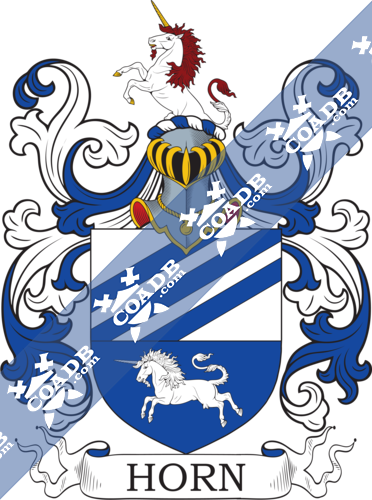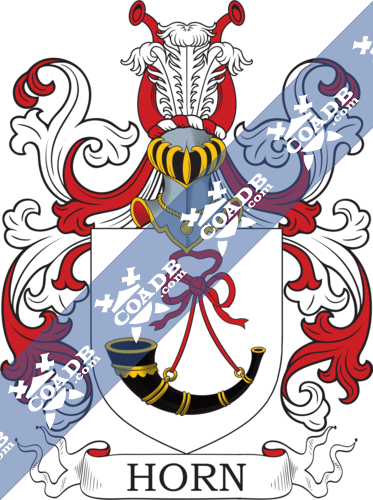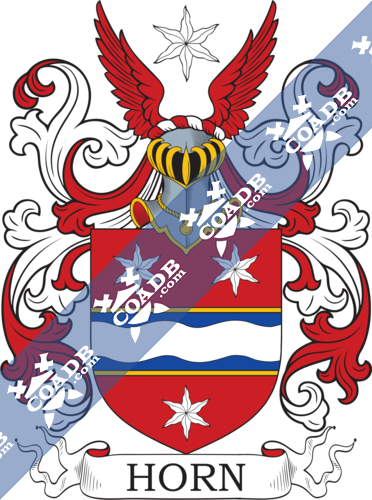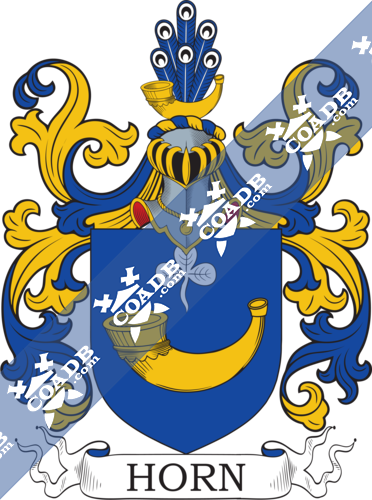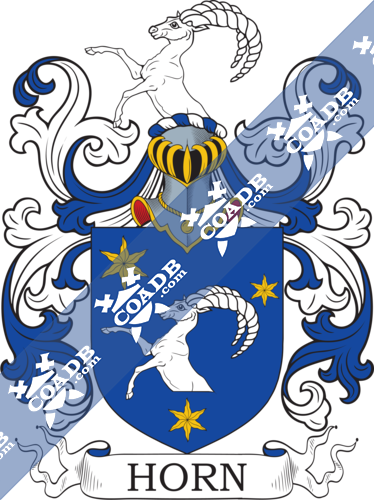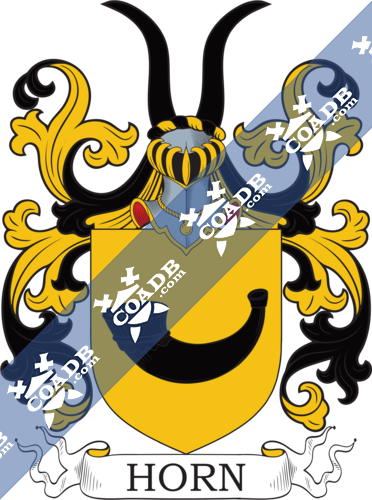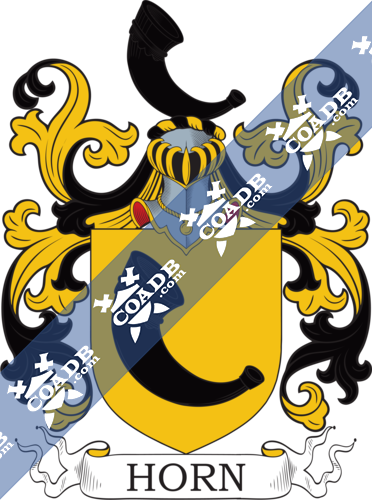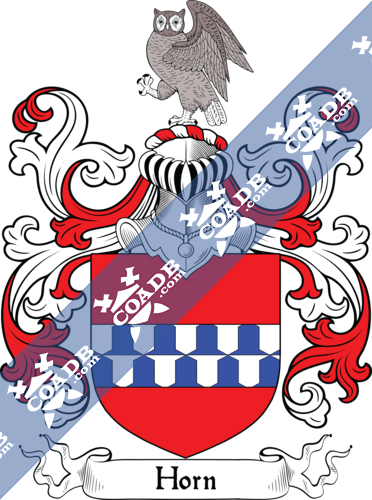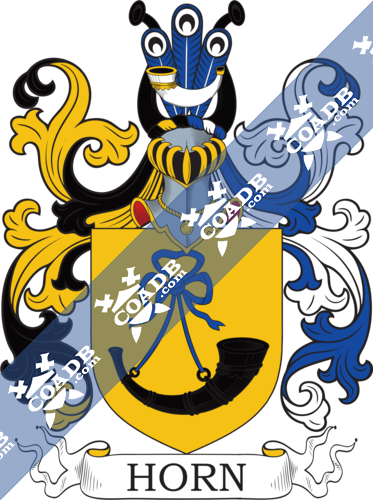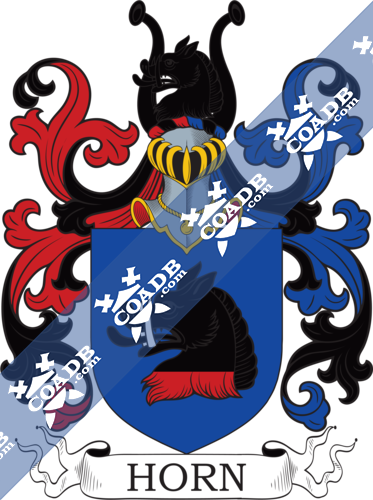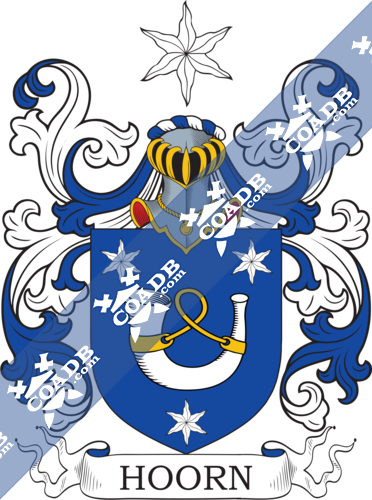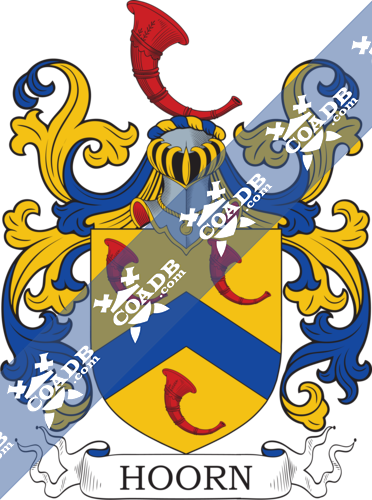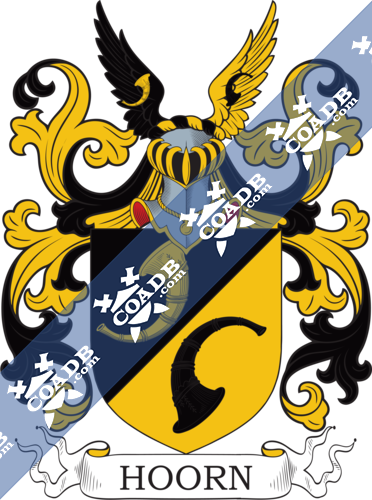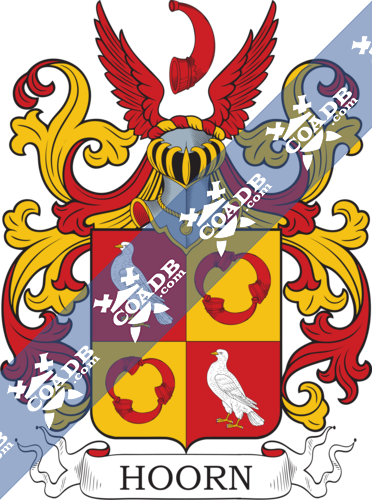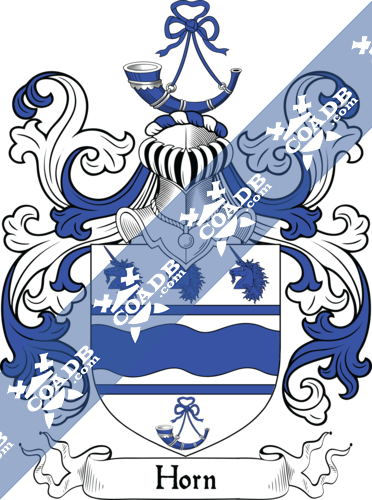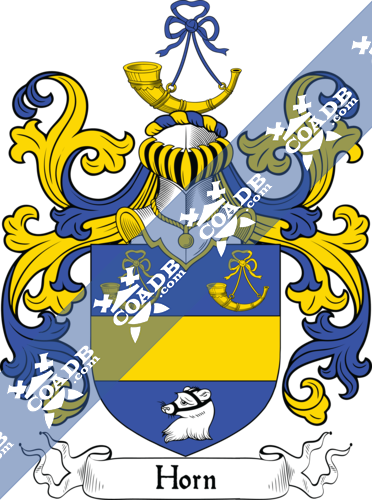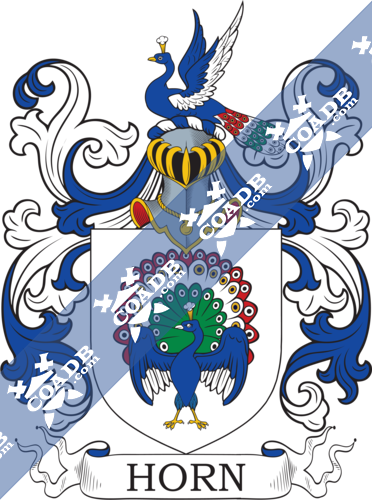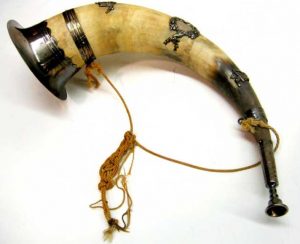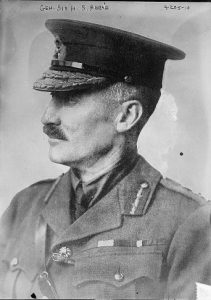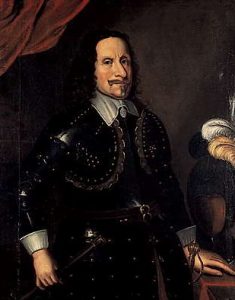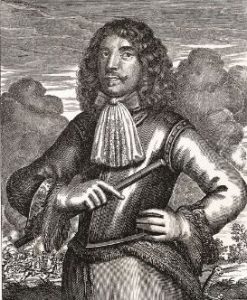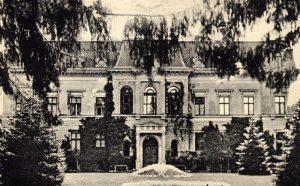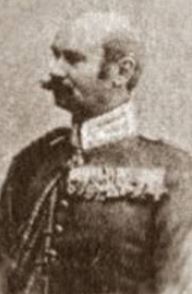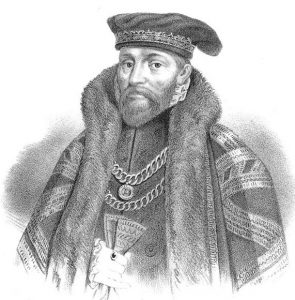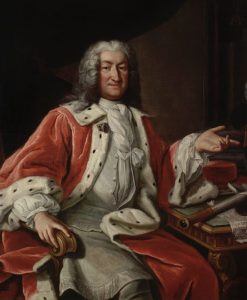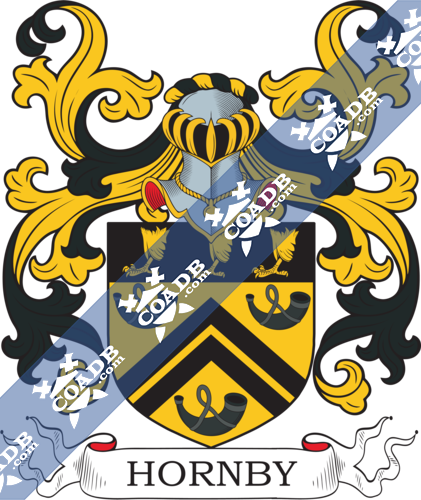Horn Family Crest, Coat of Arms and Name History

Horn Coat of Arms Gallery
Don’t know which Coat of Arms is yours?
We can do a genealogical research. Find out the exact history of your family!
Learn MoreSurname Name Meaning, Origin, and Etymology
The Anglo-Scandinavian, German, and Dutch last name Horn has ten different origin theories and meanings. First, it could mean “the son of Horn”, deriving from the personal (first) name Horn, a given name of great antiquity born by a celebrated hero of old English/French literature. Second, it might be a locational name meaning “of Horne”, a parish in county Kent, England. Third, it may be a locational name deriving from “at the Horn” a sign name. In theories two and three, the place name could derive from the shape of the piece of the land they were on, a piece of ground shaped like a horn or hook. (ex. Horne in Surrey and Horn in Rutland). Fourth, it could be an occupational name, deriving from the Middle English, Middle Dutch, and Middle High German word horn, meaning horn, referring to a person who made small articles (ex. spoons and combs) out of animal horn. Fifth, it could be an occupational name for someone who played a musical instrument made from the horn of an animal. In the Middle Ages or medieval times, workers were sometimes summoned by the flowing of a horn. Sixth, it may have derived from a physical feature from a person (such as a hooked nose?). Seventh, it may denote a a cuckolded husbanded. Eighth, it could be a Norwegian habitational name for a person who lived on farms so named (there are over 10), deriving from the Old Norse word horn, meaning horn or spur of land. Ninth, it could be a Swedish topographic. Tenth, it may be a Jewish name derived from a ram’s horn (shofar in Hebrew), which was blown at certain ceremonies in the synagogue, the Jewish house or worship. Tenth, it could be a locational name taken from various placed in the Netherlands or Holland named Hoorn, as the Dutch word hoorn means point or nook, and the prefix Van means “from”.
This page serves as a great resource for those interested in not only in heraldry, but also the Horn family genealogy and Horn ancestry.
Spelling Variations
Common spelling variants or names with similar etymologies include several English variants (Horne, Athorne, Athorn, Orne), Dutch/German variants (Hoorn, Van Horn, Van Hoorn, Van Horne, Van den Horn), and Norse/Norwegian variants (Hjorn or Orn). Another possible variant is Hurne.
Popularity & Geographic Distribution
The last name Horn ranks 593rd in popularity in terms in the United Status as of the 2000 Census. The name ranks particularly high in the following ten states: Kentucky, Oklahoma, Missouri, Arkansas, Pennsylvania, Michigan, Indiana, Kansas, Montana, and Oregon.
The name is popular throughout all of English and German parts of Europe, as well as Scandinavia: Germany (91st), Norway (285th), Denmark (510th), Austria (569th), Switzerland (945th), Sweden (1,145th), England (1,235th), Scotland (1,168th), Estonia (1,374th), Netherlands (2,128th), Finland (2,462nd), and Wales (2,662nd).
The name is also present outside of Europe is notable numbers: Canada (2,383rd), New Zealand (1,421st), Australia (1,592nd), and South Africa (329th).
The 1890 book Homes of Family Names by H.B. Guppy, states the following in regard to this surname: “The name of Horn or Horne, at present well represented around Wisbech, is also found in Kent. It was also represented in these two counties in the 13th century, as well as in London, Suffolk, Sussex, Oxfordshire, Cambridgeshire, Hunts, Northamptonshire, and Wilts”.
In the Netherlands, the spelling van Hoorn is the 748th most popular surname in the country.
Early Bearers of the Surname
Alwin Horne owned lands in counties Middlesex and Hertfordshire, England prior to 1086 AD. The Hundred Rolls of 1273 AD, a census of Wales and England, known in Latin as Rotuli Hundredorum lists four bearers of this surname: Adam Horn in county Wiltshire, Henry Horn in Northampton, Walter Horn in county Oxford, and Roger de Horne in county Kent. The Poll Tax of Yorkshire in 1379 AD lists one bearer of this last name: Johannes Horne. Kirby’s Quest lists two bearers of this name living around 1327 AD, both in county Somerset: William atte Horn and Thomas atte Horne. In the Netherlands, Herman van Hoorn (or Horne) (died in 1156 AD) and was Archdeacon at Liege and Bishop of Utrecht.
George Fraser Black’s 1946 book The Surnames of Scotland states the following in regard to this surname: “A well-known Old English personal name, probably of Norse origin. Aluuin Horme in DB. John Horn was beaten and evil-treated on the Border, 1279 . In 1328 there is entry of cockets of Lochmaben for Alan Home. John Horn apud Fervy, forestaller in Aberdeen, 1402. David Home is mentioned in a sasine relating to Cupar, 1456, and Agnes Horn is recorded in Glasgow, 1487. John Horne was admitted burgess of Aberdeen, 1497, and Alexander Horne contributed towards church repairs there in 1508. William Horn, attorney for Robert, archbishop of Glasgow, 1503, James Horne, bailie of Haddington, 1567, and Alexander Horne, canon of Ross, 1584. Horn of Westhall, an old family in Oyne, Hurne 1561”.
History, Genealogy, and Ancestry
The famous genealogist Bernard Burke’s book “Peerage and Knights” discusses one branch of this family. It begins with a mention of Sir Alan Edgar Horne, 2nd Baronet, M.C. of Shackleford in county Surrey, who was a Lieutenant Colonel in the Pioneer Corps who served in World War I as Captain of the Surrey Yeomanry and World War II. He was born in 1889 and succeeded his father in 1941. He first married Henriette Kelly and had a daughter with her named Edith Margery Jay (who married Major Thomas Fiddian Reddaway). He later married Roslyn, daughter of John Bryan Robinson, and had a son with her named Anthony Edgar (born 1925, member of Royal Air Force, served in World War II, married Valentin Dudensing). Burke traces the lineage back to Edgar Horne of Witley in county Surrey, who had several issue, the elder son being Sir William Edgar Horne, 1st Baronet, Justice of Peace in county London and Deputy Lieutenant in county Sutherland, as well as Westminiser City Countil Member, Mayor, and Alderman, among other positions. He was born in 1856 and was created a Baronet in 1929. In 1886, he married Margery, daughter of George Anderson May, of Elford, county Stafford, and had children with her: Alan (2nd Baronet discussed above), William Guy (Major in the 10th Hussars who served in both World Wars), and Pyhyllis Margery (born 1888). They bore the following Horne Coat of Arms (mistakenly called Horne Family Crest by those unfamiliar with heraldry): Gules, a fret vair between two boars, passant one in chief and one in base or. Crest: A dexter arm vested gules, cuffed or, holding in the hand proper, a hunting horn and charged on the sleeve with a fret gold. Clubs: Marlborough-Windham; Cavalry.
The branches of the Horn family tree and discussions of Horn genealogy would take of volumes and are too numerous to cover here. We can briefly discuss some Horn pedigrees.
A Horn whose first name is not recorded to history was born around 1150 AD and had two sons: Engelbert of Horn and Willem of Horn. His son Willem was born around 1170 and had two sons: Willem and Engelbert. The former was born around 1210 AD and he had two sons: Dick of Horn and Willem van Horne. The latter was born in Horn, Limburg, Netherlands around 1240. He married Agnes Marbais and had four issue with her: Willem, Dirk, Gerald I, and Isabelle. His son Gerald I “Heer van Horne” was born in Horn, Limburg in 1265 AD. He married Johanna van Leuven and later Ermgaris von Kleve and had the following issue with her: Margaretha, Willem IV and Diederik. His son Willem IV “Heer van Horne” was born in the same town around 1303 AD. He married Oda van Putten en Strijen and later Elisabeth von Kleve and had the following children: Agnes , Oda, Aleid, Elisabeth, Gerald II, Johanna, Willem V, Dirk Loef, and Elisabeth. His son Willem V was born around 1324. He married Mechtild van Arkel and had a son with her named Willem. This Willem Horne was born in 1358 and he married Johanna Heinsberg, with whom he had a son named Willem. This Willem Horne was born around 1380 and he married Johanna Montigny. They had a son named Jacob. Jacob of Horne was born around 1420.
Johann Krofft Horn was born in Elsoff, Westphalia, Germany in 1670. He married Christiana Elizabeth Hayn Bach and had four issue with her: Johann Matthias, Johannes Krofft, Anna Maria, and Christina. His son Johann Mattias (or Matthew) Horn was born in the same town in 1716. He had a son named Aaron. Aaron Horn was born in the same town in 1740. He came to colonial America. Prior to his 1778 death in Kentucky, he had the following issue: Sarah (Dumford), Polly (Proctor), Jerimiah, Matthias, Aaron, William, and Christopher. His son Matthias (Matthew) Horn was born around 1761 in Betterton, Maryland. He married Sussannah Hall and had the following children with her: John Sr., Keziah Jane (Meadows), Nancy (Barnett), Susannah (Meadows), Elijah, Aaron B., and Margaret. His son John Horn Sr. was born in Kentucky around 1705.
A one John Horn was born in East Nantmel, Chester in 1737. He married Mary Margaret and had a son named Samuel. Samuel was born in Chester, PA in 1765 and he married Hannah Wampole, with whom he had three issue: Elias, George W., and Elizabeth.
A one John Horn was born around 1775 and he married Ann Collins in Devon, England. They had four issue together: John, Anne Soper, Thomas, and Jane Downe. His son Thomas was born in Launcells, Cornwall around 1798 and he married Margaret Danning. They had the following children together: John Horn, Ann Horn, Phillipa Octavia (Gumpel), Thomas, Thomas Danning, Mary Jane (Pappin), William, and Emanuel.
Early American and New World Settlers
Joseph Horne, age 21, came to Virginia aboard the Transport of London in July 1635.
Richard Horne, age 22, came to Barbados aboard the Expedition in November 1635.
Henry Horn was recorded as living in Virginia (“over the River”) in February 1623, as was one Richard Hornn.
Gustav Adolphus Horn came to Barbados aboard the William & Anne in 1679.
A one Mary Horn, widow, was recorded as buried in the parish of St. Michaels, Barbados in 1678
The book Genealogical Guide to the Early Settlers, mentions three persons bearing this last name:
1) Armstrong Horn of Exeter, who took fidelity in 1667, but this may be a recording error
2) John Horn of Salem, 1630, who may have come in the fleet with Governor Winthrop, but perhaps earlier, was a freeman in 1631 and was a deacon. He died at age 82 in 1682. He had issue named Jonathan, Recompense, John, Simon, Joseph, Benjamin, Elizabeth Gardner, Jehoadan Harvey, Mary Smith, and Ann Felton. His wife may have been named Ann. His descendants may spell the name Orne.
3) William Horn of Dover, 1639, at Salibury, who married Elizabeth and had children named Elizabeth (1662), John (1663), William (1674), Thomas (1676), Margaret (1679), and perhaps Mary. He was killed by an Indian assault of Dover in 1689.
Early settlers in colonial America bearing this name include Christian Bartensten Van Horn (New York City 1653), Jan Cornelissen Van Horn (New Netherlands around 1645), Edward and Winifred Horn (Maryland 1664), Edward Horn (Maryland 1664), Kasper Horn (New York 1709), Gertraud Hoorn (New York 1710), Andreas Horn (Pennsylvania 1732), Ulrich Horn (Pennsylvania 1737), Joanis Horn (Pennsylvania 1741), Margretha Horn (Pennsylvania 1743), and Johan Philips Hoorn (Philadelphia 1770).
Early Americans Bearing the Horn Family Crest
I researched the following three resources and did not find any coats of arms for Horn: Bolton’s American Armory, Matthew’s American Armoury and Bluebook, and Crozier’s General Armory.
Mottoes
We have identified four Horn family mottoes:
1) Nil desperandum, meaning “Never despair” (of Durham)
2) *Monitus munitus, meaning “Foewarned, forearned” (of Westerhall)
3) Moneo et munio, meaning “” (of Aberdeen)
4) Hastings (of Bishopwearmouth)
5) True
6) Justice ac sincer, meaning “Justice and sincerity(?)” (of Posnanie)
7) Parta tueri, meaning “Defend what you have won” (of Berlin)
8) Electus a Deo beatus, meaning “Hapilly chosen by God(?)” (of Zélande)
*This motto refers to the notes of alarm given by the horn which forms the crest, as well as to the owner’s name.
Grantees
We have 58 coats of arms for the YYYY surname depicted here. The first 8 blazons are from Bernard Burke’s book The General Armory of England, Ireland, and Scotland, which was published in 1848. The next 50 blazons (nos. 9-58) are from the Armorial General published in 1861 by the famous genealogist/heraldist Johannes Baptisa Rietstap, which tends to cover mainland Europe (Germany, Holland, Belgium, Switzerland, France, Austria, Czechoslovakia, Poland, Denmark, Sweden, Italy, Spain, etc.). The bottom of this page contains the blazons (in French and English), and in many instances contains some historical, geographical, and genealogical about where coat of arms was found and who bore it. People with this last name that bore a Horn Coat of Arms include:
1) Horne, first name not recorded, crest, Barker’s Grants
2) Robert Horne, Bishop of Winchester, arms only, 10 February 1560-1, by G. Dethick
Notables
There are hundreds of notable people with the Horn surname. This page will mention a handful. Famous people with this last name include: 1) Alfred Horn (1918-2001), born in Lower East Side, Manhattan, who was an American mathematician who was known for his work in lattice theory and universal algebra, 2) Carl von Horn (1903-1989) who was born in Vittkovle and was a Swedish Army general known for his service in various United Nations missions, including the Congo Crisis (1960s), 3) Carl Graf von Horn (1847-1923) who was a Bavarian Colonel Generaland War Minister born in Wurzburg, 4) Charles Edward Horn (1786-1849) who was an English composer and singer born in St. Marin-in-the-Fields, London whose works include Rich and Poor, The Devil’s Bridge, and the Blue Stocking, 5) Donald Glenn Horn (1945) who was a NFL quarterback in the 1960s and 70s born in South Gate California who played for five different NFL teams (ex. Green Bay Packers) and one WFL team (Portland Thunder), 6) Gyula Horn (1932-2013) who was the Prime Minster of Hungary in the 1990s, 7) Count Arvid Horn bf Ekebyholm (164-1742) who was a Swedish/Finnish soldier, politician, and diplomat, considered one of the leading figures of the Swedish Age of Liberty (a period of parliamentary governance with increasing civil rights), 8) Gustav Horn af Bjorneborg (1592-1657) who was a Swedish/Finnish soldier that became the Count of Pori, High Councillor, Field-Marshall and commander in Sweden’s troops in Germany during the Thirty Years’ War, and Governor General of Livonia, 9) Joan Kelly Horn (1936) who was born in St. Louis and became a representative in the U.S. House of Representatives for Missouri in 1991, 10) Charles Frederick Horn (1762-1830) who was a composer born in Nordhauden, Germany who moved to London, England where he became a music teacher in the Royal Household, and is widely credited for introducing the classical music of Johann Sebastian Bach to English speaking world, 11) Philip de Montmorency (died 1568) who was known are the Count of Horn (or Hoorn or Hoorne) who was a victim of the Spanish Inquisition in the Netherlands, 12) John Stephen Horn (1931-2011) who was President of California State University, Long Beach, and a Republican member of the U.S. House of Representatives for California’s 38th district, 13) Tori Egil Moxness Horn (1976) who was a Norwegian football (soccer) player who played the position of goalkeeper and spent his career on the team FK Bodø/Glimt, and 14) Sidney Welby Van Horn (1920-2014) who was a retired America professional tennis player born in West Palm Beach, Florida, who became a major tennis coach, as well as reaching the finals of the U.S. Nationals in 1939.
Blazons & Genealogy Notes
2) (Bishopwearmouth, co. Durham). Gu. three herons ar. Crest—A heron close ppr. holding in the bill a standard staff, the banner flotant, thereon the word “Hastings.” Motto—Nil desperandum.
3) (Germany). Or, three buglehorns sa.
4) (co. Norfolk). Gu. on a chev. engr. betw. three herons ar. a cinquefoil of the first.
5) (co. Salop). Gu. a fesse vair. Crest—An owl ppr.
6) (co. Sussex). Gu. a fret vair.
7) Ar. a lion ramp. guard. gu.
8) (Westhall, co. Aberdeen; heiress m. Dalrymple, of Drummore. See Dalrymple). As recorded 1685—Ar. a. fesse wavy cotised az. betw. three unicorns’ heads couped in chief and a buglehorn in base, garnished of the first, stringed of the third. Crest—A buglehorn az. garnished and stringed ar. Motto—Monitus munitus.
9) Altered, 1725, to or, three hunting horns gu. Crest—Two horns conjoined, parted per fess or and sa. Motto—Moneo et munio.
10) (Edinburgh, 1855). Az. a fess or, betw. two hunting horns in chief of the second and a bear’s head in base erased ar. muzzled sa. Crest—A hunting horn or, stringed az. Motto—Monitus munitus.
10) Horn – Prusse (P. d’Eichsfeld) – D’argent à un paon rouant au naturel posé de profil Cimier un paon issant au naturel le vol levé Lambrequin d’argent et d’azur. English: Argent with a peacock in its pride proper placed in profile Crest: a peacock issuant proper the pair of wings upright Mantling: argent and azure.
11) Horn – Rothenburg (Bavière) – D’azur à trois cors de chasse d’argent liés virolés et enguichés d’or Cimier un homme issant habillé d’azur donnant dans un huchet d’argent. English: Azure three hunting horns argent tied [banded] bands [encircling the horn] and rimmed with metal or Crest: a man issuant dressed azure giving (blowing?) in a hunting horn [without bands] argent.
12) Horn – Posnanie – (An., 28 déc. 1865) – D’azur à trois huchets de sable virolés d’argent rangés en pal Cimier un panache de trois plumes d’autruche d’une de sable entre deux d’argent ch d’un huchet de l’écu Lambrequin d’argent et d’azur Devise JUSTE AC SINCERE. English: D’azur à trois huchets de sable virolés d’argent rangés en pal Cimier un panache de trois plumes d’autruche d’une de sable entre deux d’argent ch d’un huchet de l’écu Lambrequin d’argent et d’azur Devise JUSTE AC SINCERE
13) Horn – Prusse – (An., 1 sept. 1772) – Écartelé au 1 de gueules à une ancre de sable au 2 de gueules à un senestrochère armé tenant une épée le tout d’argent au 3 de gueules plein au 4 de gueules à deux étoiles d’argent accostées au canton senestre du chef A un navire d’argent brochant en pointe sur les deux derniers quartiers Casque couronné Cimier le senestrochère posé sur le coude Lambrequin à l’intérieur et à l’extérieur de sinople. English: Quarterly 1st gules with an anchor sable 2nd gules with a left arm armed holding a sword all argent 3rd gules plain [uncharged] 4th gules two etoiles argent side by side a canton sinister from the chief Overall a ship argent covering in base over the two last quarters Crowned with a helmet Crest: the left arm placed over the elbow Mantling: with the interior and on the outside vert.
14) Horn – Suède, Prusse – (Ren. de nob., 12 déc. 1824, 10 juillet 1825, 3 oct. 1833 et 21 mai 1834) – De gueules à un cor de chasse d’or virolé et enguiché du même Casque couronné Cimier deux huchets d’or en pals entrelacés les embouchures en haut surmontés d’une étoile d’or. English: Gules with a hunting horn or bands [encircling the horn] and rimmed with metal of the same Crowned with a helmet Crest: two hunting horn [without bands] or palewise interlaced the mouth upwards surmounted by a etoile or.
15) Horn – Westphalie – D’argent à un ours rampant de gueules colleté d’or Cimier l’ours issant. English: Argent with a bear rampant gules collared or Crest: the bear issuant.
16) Horn – Silésie – (Barons, 24 avril 1671) – D’or à deux piques au naturel emmanchées de sable passées en sautoir liées d’un ruban flottant d’azur Cimier un cor de chasse de sable lié virolé enguiché et pavillonné d’or. English: Or two pike [weapon] proper handle sable placed saltirewise tied [banded] a ribbon flying azure Crest: a hunting horns sable tied [banded] bands [encircling the horn] rimmed with metal and the bell (of the horn) or.
17) Horn – Suède – (Barons, 1763. M. ét. en 1782) – D’or à un cor de chasse de sable lié d’azur l’embouchure à dextre l’écu bordé d’argent Deux casques couronnés Cimiers 1° une queue de paon au naturel ch du cor de chasse entre deux proboscides de sable 2° deux bras armés au naturel les mains de carnation tenant ensemble un écusson d’azur sommé d’une couronne royale d’or et ch d’un G du même Supports à dextre un lion regardant d’or lampassé de gueules à senestre un griffon regardant de gueules. English: Or with a hunting horn sable tied [banded] azure the mouthpiece to the dexter the shield fimbriated argent Crowned with two helmets Crests: 1st a tail of peacock proper charged with hunting horns between two proboscides sable 2nd two arm armed proper the hands carnation holding together an escucheon azure surmounted by a Royal crown or and charged with a G of the same Supporters to the dexter a lion reguardant or langued gules to the sinister a griffin reguardant gules.
18) Horn – Berlin – (An., 28 déc. 1865) – D’azur à trois huchets de sable virolés d’argent rangés en pal Cimier un panache de trois plumes d’autruche d’une de sable entre deux d’argent ch d’un huchet de l’écu Lambrequin d’argent et d’azur Devise PARTA TUERI. English: Azure three hunting horn [without bands] sable bands [encircling the horn] argent arranged palewise Crest: a plume of three ostrich feathers a sable between two argent charged with a hunting horn [without bands] of the shield Mantling: argent and azure Motto: PARTA TUERI.
19) Horn – Franconie – D’or à trois cornes de bouquetin de gueules mal-ordonnées celle en chef couchée le sommet à dextre les deux autres adossées et le sommet en bas à une rose de gueules en abîme Cimier une rose de gueules entre deux cornes de bouquetin coupées d’or sur gueules. English: Or three horns of ibex gules disordered [1 2] that in chief laying on the ground the tip to the dexter the two others addorsed [back to back] and the tip downwards with a rose gules in fess point Crest: a rose gules between two horns of ibex per fess or over gules.
20) Horn – Allemagne – D’azur à trois roses d’or Casque couronné Cimier deux proboscides coupées alternativement d’azur et d’or. English: Azure three roses or Crowned with a helmet Crest: two proboscides per fess alternately azure and or.
21) Horn – Bavière, Prov. rhénanes – (Nob. du St.-Empire, 17 mars 1783; barons bavarois, 16 mars 1791; barons de l’Empire français, 3 janv; 1813) – Coupé au 1 d’argent à trois barres d’azur au 2 d’azur à une licorne courante d’argent Casque couronné Cimier la licorne issante. English: Per fess 1st argent three bendlets sinister azure 2nd azure with a unicorn courant [running] argent Crowned with a helmet Crest: the unicorn issuant.
22) Horn – Poméranie citérieure (Vorpommern) – D’argent à un cor de chasse de sable virolé et enguiché d’or lié de gueules Cimier trois plumes d’autruche d’argent entre deux proboscides de gueules. English: Argent with a hunting horns sable bands [encircling the horn] and rimmed with metal or tied [banded] gules Crest: three ostrich feathers argent between two proboscides gules.
23) Horn – Poméranie ultérieure (Hinterpommern) – D’argent à un cor de chasse de sable lié virolé et enguiché d’or Cimier le cor de chasse suspendu au sommet d’une colonne d’argent sommée d’une queue de paon au naturel. English: Argent with a hunting horns sable tied [banded] bands [encircling the horn] and rimmed with metal or Crest: the hunting horns suspended from from the summit a column [pillar] argent surmounted by a tail of peacock proper.
24) Horn – Nuremberg – Tranché de sable sur or à deux cors de chasse posé dans le sens du tranché de l’un à l’autre celui en bas renversé Cimier un vol à l’antique d’or ch d’un cor de chasse de sable en bande (V van Hoorn au P d’Utrecht). English: Per bend sable over or two hunting horns placed in the direction of per bend counterchanged the one downwards reversed Crest: a pair of wings with ancient or charged with a hunting horns sable bendwise.
25) Horn – P. de Brême – D’argent à un huchet de sable. English: Argent with a hunting horn [without bands] sable.
26) Horn – van Der Horn – Harlem – De gueules à une fasce d’azur bordée d’or chargée d’une fasce ondée d’argent et acc de trois étoiles du même Cimier une étoile d’argent entre un vol de gueules. English: Gules with a fess azure fimbriated or charged with a fess undy argent and accompanied by three etoiles of the same Crest: an estoile argent between a pair of wings gules.
27) Horn – von Horn – Hollande, Suède – D’azur à un huchet d’or l’embouchure à senestre surmonté d’un trèfle d’argent Casque avec lambrequins d’or et d’azur Cimier le huchet d’or soutenant un écran de six plumes de paon au naturel 3 2 et 1. English: Azure with a hunting horn [without bands] or the mouthpiece to the sinister surmounted by a trefoil argent helmet with Mantling: or and azure Crest: the hunting horn [without bands] or supporting a fan shaped crest [german] of six peacock feathers proper 3 2 and 1.
28) Horn – Horn – P. de Spire – D’azur à un bouquetin naissant d’argent acc de trois étoiles d’or 1 en chef à dextre 1 en flanc à senestre et 1 en pointe Casque couronné Cimier le bouquetin issant Lambrequin d’argent et d’azur. English: Azure with a ibex naissant argent accompanied by three etoiles or 1 in chief to the dexter 1 in the flanks to the sinister and 1 in base Crowned with a helmet Crest: the ibex issuant Mantling: argent and azure.
29) Horn – Horn Af Aminne (Comte) – Suède – Comte 1746 – Coupé d’un trait coupé de deux autres qui font six quartiers aux 1 et 3 d’azur à une couronne d’or au 2 d’or au lion fascé de sept pièces d’argent et d’azur couronné d’or tenant de sa patte dextre une billette au 4 gironné d’or et de sable de huit pièces au 5 de gueules à une couronne d’or au 6 d’azur à trois bandes d’argent Sur le tout un écusson surmonté d’une couronne à sept perles d’or au huchet de sable l’embouchure à senestre Couronne à neuf perles et trois casques Cimiers 1° et 3° deux cornes de boeuf de sable 2 ° une étoile (5) Supports un lion et un griffon. English: Per fess a line per fess with two others which creates six quarters 1 and 3 azure with a crown or 2nd or of lion barry of seven pieces argent and azure crowned or holding in its paw dexter a billet 4th gyronny or and sable of eight pieces 5th gules with a crown or 6th azure three bends argent overall a escucheon surmounted by a crown with seven pearls or of hunting horn [without bands] sable the mouthpiece to the sinister crown with nine pearls and three helmets Crests: 1st and 3rd two horns of ox [with tail pendant] sable 2nd an estoile of 5 points Supporters a lion and a griffin.
30) Horn – Horn d’Aminne – Suède – (Comtes, 1772) – Écartelé aux 1 et 4 d’azur à un G sommé d’une couronne royale et le chiffre III posé dans le G le tout d’or aux 2 et 3 de gueules à un senestrochère paré d’azur ganté d’argent orné près de l’épaule d’un noeud d’argent A la croix pattée d’or brochant sur l’écartelé Sur le tout d’or à un huchet de sable l’embouchure à senestre Trois casques couronnés Cimiers 1° une trompette d’or entre deux bannières adossées celle à dextre d’azur à trois couronnes à l’antique d’or celle à senestre d’or ch du chiffre H D XIX 2° un vase d’or entre deux cornes de buffle de sable ornées chacune à l’extérieur de flammes d’or 3° un cavalier habillé d’azur coiffé d’une tricorne monté sur un cheval galopant de sable Supports à dextre un griffon regardant d’or à senestre un griffon regardant de sable. English: Quarterly 1st and 4th azure with a G surmounted by a Royal crown and the figure III placed in the G all or 2nd and 3rd gules with a left arm clothed [dressed] azure gloved argent decorated near to the shoulder a knot (bow) argent Overall the cross pattee or covering over the quarterly overall or with a hunting horn [without bands] sable the mouthpiece to the sinister Crowned with three helmets Crests: 1st a trumpet or between two square flags addorsed [back to back] that to the dexter azure three crowns with ancient or that to the sinister or charged with of figure H D XIX 2nd a vase or between two buffalo horns sable decorated each on the outside of flame or 3rd a cavalier dressed azure wearing on the head a tricorn (hat) mounted over a horse galloping sable Supporters to the dexter a griffin reguardant or to the sinister a griffin reguardant sable.
31) Horn – Horn d’Aminne – Suède – (Barons, 1561. M. ét. en 1775) – D’or à un huchet de sable l’embouchure à senestre Casque couronné Cimier deux cornes de buffle de sable. English: Or with a hunting horn [without bands] sable the mouthpiece to the sinister Crowned with a helmet Crest: two buffalo horns sable.
32) Horn – Horn de Björneborg – Suède – (Comtes, 1651. M. ét. en 1657) – Écartelé au 1 de gueules à un drapeau d’argent flottant à senestre la hampe de sable posée sur deux pierres carrées de sinople entassées en piramide vues de biais au 2 d’argent à un ours contourné de sable colleté d’or grimpant sur une échelle de sable posée en barre au 3 d’argent à un ours rampant de sable couronné d’or tenant un pistolet au naturel l’ours accosté en pointe de deux étoiles d’or au 4 d’azur à deux pennons de gueules les trabes au naturel passées en sautoir Sur le tout d’or à un huchet de sable l’embouchure à dextre Trois casques couronnés Cimiers 1° un chevalier issant armé d’argent la visière fermée le casque panaché de gueules et d’azur tenant un bâton de commandement d’argent appuyé sur sa hanche 2° deux cornes de buffle de sable 3° huit pennons alternativement d’azur et de gueules quatre à dextre et quatre à senestre. English: Quarterly 1st gules with a flag argent flying to the sinister the pole [of the flag] sable placed over two square stones (jewels) vert heaped in a pyramid seen at an angle 2nd argent with a bear reversed sable collared or rampant over a ladder sable placed bendwise sinister 3rd argent with a bear rampant sable crowned or holding a pistol proper the bear side by side in base of two etoiles or 4th azure two small triangular flags gules the flag staffs proper placed saltirewise overall or with a hunting horn [without bands] sable the mouthpiece to the dexter Crowned with three helmets Crests: 1st a knight issuant armed argent the visor closed the helmet plumed gules and azure holding a baton of commandment (military baton) argent resting on his hip 2nd two buffalo horns sable 3rd eight small triangular flag alternately azure and gules four to the dexter and four to the sinister.
33) Horn – Horn d’Eger – Prusse – D’or à un cor de chasse de sable Cimier le cor de chasse. English: Or with a hunting horns sable Crest: the hunting horns.
34) Horn – Horn de Kankas – Suède – D’or à un huchet de sable l’embouchure à senestre Casque couronné Cimier deux cornes de buffle coupées alternativement d’or et de sable. English: Or with a hunting horn [without bands] sable the mouthpiece to the sinister Crowned with a helmet Crest: two buffalo horns per fess alternately or and sable.
35) Horn – Horn d’Ekebyholm – Suède – (Comtes, 1706. M. ét. en 1798) – Écartelé aux 1 et 4 d’azur à deux bannières d’argent passées en sautoir aux 2 et 3 d’or à un cavalier habillé d’azur coiffé d’un tricorne de sable tenant une épée et monté sur un cheval galopant de sable houssé d’argent A une fasce de pourpre brochant sur le tout ch à dextre et à senestre de deux rameaux de laurier de sinople passés en sautoir chaque sautoir enfilé d’une couronne d’or Sur le tout d’or à un huchet de sable l’embouchure à dextre Trois casques couronnés Cimiers 1° quatre bannières alternativement d’azur et d’argent deux à dextre et deux à senestre 2° deux cornes de buffle coupées alternativement de sable et d’or 3° une épée d’argent garnie d’or brochant sur deux rameaux de laurier de sinople courbés en couronne les pieds passés en sautoir Supports deux chevaux d’argent. English: Quarterly 1st and 4th azure two square flags argent placed saltirewise 2nd and 3rd or with a cavalier dressed azure wearing on the head a tricorn hat sable holding a sword and mounted on a horse galloping sable caparisoned (decorative saddle & reins) argent a fess of purpure covering overall charged with to the dexter and to the sinister with two branches of laurel vert placed saltirewise each saltire encircled by a crown or overall or with a hunting horn [without bands] sable the mouthpiece to the dexter Crowned with three helmets Crests: 1st four square flags alternately azure and argent two to the dexter and two to the sinister 2nd two buffalo horns per fess alternately sable and or 3rd a sword argent hilt and pommell or covering over two branch of laurel vert curved in crown the feet placed saltirewise Supporters two horses argent.
36) Horn – Horn de Marienborg – Suède – (Barons, 1651. M. ét. en 1728) – Écartelé aux 1 et 4 de gueules à une bannière flottante à senestre posée sur deux pierres carrées entassées en piramide vues de biais le tout d’argent aux 2 et 3 d’azur à deux guidons d’argent attachés à des lances de tournoi au naturel passées en sautoir Sur le tout d’or à un huchet de sable l’embouchure à senestre Deux casques couronnés Cimiers 1° deux cornes de buffle de sable 2° huit guidons alternativement d’or et d’azur quatre à dextre et quatre à senestre. English: Quarterly 1st and 4th gules with a square flag flying to the sinister placed over two square stones (jewels) heaped in a pyramid as seen from the base all argent 2nd and 3rd azure two flags argent attached to tournament lances proper placed saltirewise overall or with a hunting horn [without bands] sable the mouthpiece to the sinister Crowned with two helments Crests: 1st two buffalo horns sable 2nd eight flags alternately or and azure four to the dexter and four to the sinister.
37) Horn – Horn de Pasterwitz – Silésie – Coupé au 1 d’azur à une licorne naissante d’argent mouv du coupé au 2 d’argent à trois fasces de gueules Casque couronné Cimier la licorne issante Lambrequin d’argent de gueules et d’azur. English: Per fess 1st azure with a unicorn naissant argent coming from per fess 2nd argent three bars gules Crowned with a helmet Crest: the unicorn issuant Mantling: argent gules and azure.
38) Horn – Horn de Pleissenburg – Bavière – (Nob. du St.-Empire, 17 avril 1742) – D’argent au lion d’azur soutenu d’une colline de sinople le champ chapé-ployé de sable ch à dextre d’une licorne rampante et contournée d’argent et à senestre d’une corne de buffle d’or le sommet en bas. English: Argent of lion azure standing on a hill vert the field chape ploye [division top centre curved to dex & sin base] sable charged with to the dexter a unicorn rampant and reversed argent and to the sinister a buffalo horns or the tip downwards.
39) Horn – Horn de Ranzin – Suède – (Comtes, 1719) – Coupé d’un trait parti de deux autres qui font six quartiers aux 1 et 6 d’azur à deux tubes de canon d’or passés en sautoir aux 2 et 5 d’argent à une grenade de guerre d’or allumée au naturel aux 3 et 4 d’argent à un griffon de gueules Sur le tout d’or à un cor de chasse de sable l’embouchure à dextre Trois casques couronnés Cimiers 1° un dextrochère armé d’argent posé sur le coude la main de carnation supportant une grenade de guerre de sable allumé d’argent 2° une queue de paon au naturel ch du cor de chasse du surtout entre deux proboscides de sable 3° le griffon du 3 issant tenant une mèche en pal allumée en haut. English: Per fess a line per pale of two others which creates six quarters of 1 and 6 azure two cannon barrels or placed saltirewise 2 and 5 argent with a bombe or aflame proper 3 and 4 argent with a griffin gules overall or with a hunting horn sable the mouthpiece to the dexter Crowned with three helmets Crests: 1st a right arm armed argent placed over the elbow the hand carnation supporting a bombe sable aflame argent 2nd a tail of peacock proper charged with a hunting horn above between two proboscides sable 3rd the griffin of the 3rd issuant holding a match palewise aflame upwards.
40) Horn – Horn de Ranzin – Suède – (Barons, 1701. M. ét. en 1775) – Écartelé au 1 d’argent à un griffon de gueules au chef d’azur ch d’une étoile d’or aux 2 et 3 de gueules à deux bannières d’or passées en sautoir acc de deux besants d’argent 1 en chef et 1 en pointe au 4 d’argent à la bande d’azur ch d’une tête de lion d’or et acc de deux quintefeuilles de gueules Sur le tout d’or à un cor de chasse de sable l’embouchure à dextre Deux casques couronnés Cimiers 1° une queue de paon au naturel ch du cor de chasse entre deux proboscides de sable 2° une étoile d’or soutenue d’une boule de gueules et supportant une autre boule du même entre deux bannières adossées d’or et d’azur. English: Quarterly 1st argent with a griffin gules a chief azure charged with an etoile or 2nd and 3rd gules two square flags or placed saltirewise accompanied by two bezants argent 1 in chief and 1 in base 4th argent a bend azure charged with a head of lion or and accompanied by two cinquefoils gules overall or with a hunting horn sable the mouthpiece to the dexter Crowned with two helmets Crests: 1st a tail of peacock proper charged with a hunting horn between two proboscides sable 2nd an estoile or supported by a ball gules and supporting another ball of the same between two square flags addorsed [back to back] or and azure.
41) Horn – Horn de Ranzin – Poméranie – D’or à un cor de chasse de sable lié d’azur l’embouchure à dextre Casque couronné Cimier le cor de chasse brochant sur trois plumes de paon au naturel entre deux proboscides de sable Lambrequin à dextre d’or et de sable à senestre d’argent et d’azur. English: Or with a hunting horn sable tied [banded] azure the mouthpiece to the dexter Crowned with a helmet Crest: the hunting horn covering over three peacock feathers proper between two proboscides sable Mantling: to the dexter or and sable to the sinister argent and azure.
42) Horn – Horn de Tutow – Poméranie – D’azur à une hure de sanglier de sable coupée de gueules défendue d’argent Cimier la hure entre deux proboscides de sable Lambrequin de gueules d’azur et de sable. English: Azure with a head of wild boar sable per fess gules tusked argent Crest: the head between two proboscides sable Mantling: gules azure and sable.
43) Hoorne – Hoorne (de) – Flandre française – D’or à trois cors de chasse de sable. English: Or three hunting horns sable.
44) Hoorne – Hoorne (van) – Hollande – De sable à trois huchets d’or. English: Sable three hunting horn [without bands] or.
45) Hoorn – Hoorn (van) de Burgh – Hollande, Zélande – (Admis au corps équestre de Zélande, 28 août 1814) – D’or à la fasce de gueules acc en chef de deux têtes et cols de cheval de sable et en pointe d’un cor de chasse du même enguiché d’azur Bourlet d’or et de sable Cimier le cor de chasse Lambrequin d’or et de sable Supports deux licornes d’argent Devise ELECTUS A DEO BEATUS. English: Or a fess gules accompanied by in chief two heads and shoulders of a horse sable and in base a hunting horn of the same rimmed with metal azure wreath on the helmet or and sable Crest: the hunting horns Mantling: or and sable Supporters two unicorns argent Motto: ELECTUS Overall DEO BEATUS.
46) Hoorn – Hoorn (van Den) – Hollande – D’or à une tête et col de cerf au naturel en chef et un cor de chasse au naturel lié d’azur en pointe. English: Or with a head and shoulders of a stag proper in chief and a hunting horns proper tied [banded] azure in base.
47) Hoorn – Hoorn (van) – Hollande – D’azur à un cor de chasse d’argent lié d’or acc de trois étoiles du second Cimier une étoile d’argent (Jean van H gouverneur-général des Indes néerlandaises 1704-1709). English: Azure with a hunting horns argent tied [banded] or accompanied by three etoiles of the second Crest: an estoile argent.
48) Hoorn – Hoorn (van) – Hollande – D’argent à un cor de chasse de gueules virolé enguiché et pavillonné d’or lié et fourré d’azur. English: Argent with a hunting horns gules bands [encircling the horn] rimmed with metal and the opening (of the horn) or tied [banded] and strings azure.
49) Hoorn – Hoorn (van) – Hollande – D’argent à trois cors de chasse de sable liés de gueules virolés et enguichés d’or Cimier un cor de chasse de l’écu posé en pal l’embouchure en bas la courbe à senestre. English: Argent three hunting horns sable tied [banded] gules bands [encircling the horn] and rimmed with metal or Crest: a hunting horns of the shield placed palewise the mouthpiece downwards the bend to the sinister.
50) Hoorn – Hoorn (van) – Zélande – D’or au chevron d’azur acc de trois cors de chasse de gueules Cimier un cor de chasse de gueules. English: Or a chevron azure accompanied by three hunting horns gules Crest: a hunting horns gules.
51) Hoorn – Hoorn (van) – Zélande – D’or à trois corbeaux de sable. English: Or three crows sable.
52) Hoorn – Hoorn (van) – P. d’Utrecht – Taillé de sable sur or à deux cors de chasse adossés de l’un à l’autre posés dans le sens du taillé Cimier un vol à l’antique de sable et d’or chaque aile ch d’un cor de chasse de l’un à l’autre dans la position qu’ils occupent dans l’écu (V Horn à Nuremberg). English: Per bend sinister sable over or two hunting horns addorsed [back to back] counterchanged placed in the direction (of) per bend sinister Crest: a pair of wings ancient sable and or each wing charged with a hunting horn counterchanged with in the position which it occupies in the shield.
53) Hoorn – Hoorn (van) – Amsterdam – D’or à un huchet de sable virolé et enguiché d’argent Cimier le huchet supportant dans sa courbe un tuyau d’or duquel s’élèvent trois plumes d’autruche Ou Coupé au 1 les armes de van Hoorn au 2 les armes de van Estel qui sont parti a d’argent à un demi-vol contourné et abaissé de sable b d’argent à quatre barres de sable. English: Or with a hunting horn [without bands] sable bands [encircling the horn] and rimmed with metal argent Crest: the hunting horn [without bands] supporting in its strings a pipe (cylinder) or from which emerge three ostrich feathers (alternatively) per fess 1st the coat of arms of van Hoorn 2nd the coat of arms of Van Estel which are per pale a) argent with a single wing reversed and abased [lower than normal] sable b) argent four bendlets sinister sable.
54) Hoorn – Hoorn (van) – Amsterdam – D’or à un cor de chasse de sable lié de gueules enguiché virolé et pavillonné d’argent acc de trois étoiles de gueules. English: Or with a hunting horn sable tied [banded] gules rimmed with metal bands [encircling the horn] and the opening (of the horn) argent accompanied by three etoiles gules.
55) Hoorn – Hoorn (van) – Amsterdam – Divisé en chevron de gueules sur azur au chevron d’or brochant sur la division acc en chef à dextre d’une cloche d’or à senestre d’une anille du même et en pointe d’un huchet d’or. English: Divided in chevron gules over azure a chevron or covering over the division accompanied by in chief to the dexter a bell or to the sinister a mill rind of the same and in base a hunting horn [without bands] or.
56) Hoorn – Hoorn (van) – Gand – D’or à un cor de chasse de sable lié virolé et enguiché d’or. English: Or with a hunting horns sable tied [banded] bands [encircling the horn] and rimmed with metal or.
57) Hoorn – Hoorn (van) – Amsterdam – Écartelé aux 1 et 4 de gueules à une colombe au naturel aux 2 et 3 d’or à trois huchets de gueules enlacés en triangle l’embouchure de l’un enfoncée dans l’ouverture de l’autre Cimier un huchet en pal l’embouchure en haut entre un vol Ou Écartelé aux 1 et 4 les huchets aux 2 et 3 la colombe. English: Quarterly 1st and 4th gules with a dove proper 2nd and 3rd or three hunting horns [without bands] gules interlaced in a triangle the mouthpiece of the one enclosed in the opening of the other Crest: a hunting horn [without bands] palewise the mouthpiece upwards between a pair of wings (alternatively) quarterly 1st and 4th the hunting horn [without bands] 2nd and 3rd the dove.

